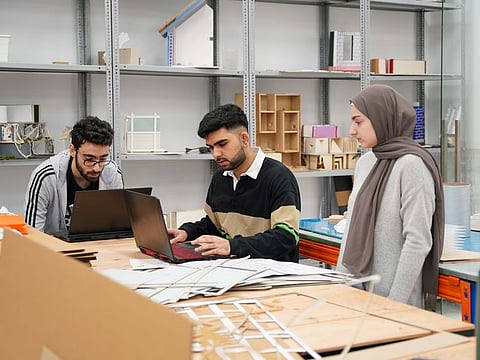The Future of Architecture and Design
How the next generation of design professionals can help build a sustainable world

Architecture and design are accelerating at an unprecedented pace. With the urgent need to adopt sustainable solutions while embracing the potential of emerging technologies, the next generation of designers has the capacity to lead a transformation that could make a significant contribution to tackling the looming climate crisis.
Massimo Imparato, Dean of the School of Architecture and Interior Design at Canadian University Dubai, explains the industry's emerging trends and how the next generation of professionals can lead the change towards a sustainable circular economy.
What are the emerging and future trends impacting architecture and design?
Architects and designers are increasingly tasked with confronting the pressing societal, environmental, and economic challenges brought about by the climate crisis. The imminent arrival of the post-carbon era presents opportunities to fundamentally reshape our world, and the design industry has a significant role to play in this.
The objectives outlined in the United Nations Sustainable Development Agenda, alongside measures agreed at climate change conferences—most recently, COP28 in Dubai—have accelerated a shift towards prioritizing the phase-out of fossil fuels. The traditional view of the planet as an infinite source of resources is giving way to a regenerative approach, where value can be generated throughout the entire lifecycle of materials, products, and systems. Emerging and future architects and designers will need to approach projects with a restorative mindset.
How are you responding to this trend as educators of future designers?
At Canadian University Dubai, the Sustainable Development Goals (SDGs) outlined in the UN Agenda are seamlessly integrated into the curriculum. From the outset of their studies, students at CUD familiarize themselves with this framework and are provided with opportunities to tackle those goals that align closely with their chosen educational path.
Within the School of Architecture and Interior Design, students are tasked with incorporating SDGs into their projects across various sectors such as living spaces, workplaces, healthcare facilities, educational environments, retail outlets, and entertainment venues. Equally significant is the training we provide in viewing sustainability holistically, enabling students to dissect complex scenarios into manageable subsystems, collaborate effectively with project stakeholders, and create meaningful value for the community.
What role will emerging technologies like AI, big data, etc. play in the future of design?
The digital revolution, along with its cutting-edge generative processes, serves as a catalyst for change and innovation. It plays a pivotal role in expanding the scope and enhancing the quality of data collection, processing, and accessibility. Much debate surrounds the integration of these technologies into design education and practice, with concerns about the potential marginalization of designers' roles in content creation and representation, which are core aspects of any design process. However, we maintain a different perspective about their position in the design landscape.
We believe that digitally augmented design tools, particularly those driven by generative AI, will accentuate the necessity for designers with deep subject knowledge and advanced critical thinking skills. This necessity will become even more pronounced due to their capacity to discern and navigate an increasingly vast array of available options, ultimately empowering them to make more informed decisions.
How can design contribute to a sustainable future?
Design possesses the ability to foster active engagement with communities and decision-makers, thereby enhancing the liveability of human spaces. By viewing cities as living ecosystems—where transportation, construction, energy, waste, and food are managed in an integrated way through policies and regulations, green urban planning, net-zero building design, and servitization of goods—designers can enact positive change upon the environment.
This multi-scalar approach harmonises seamlessly with a radical transformation of how we source, process, manufacture, deliver, and utilize goods. It marks a shift from a linear cradle-to-grave model to a circular cradle-to-cradle approach, facilitating our transition towards a sustainable circular economy.
Can you share examples of developments that are leading the transformation?
From the ground-breaking concept of Masdar in Abu Dhabi to the innovative urban planning showcased at Sustainability City in Dubai, and the cutting-edge Bee’ah headquarters in Sharjah, the UAE has committed itself to mastering advanced design solutions that harmonize the built environment with its local climate and distinctive challenges.
This approach presents unparalleled opportunities to expand and enhance the realm of design and its potential outcomes, while also honoring the legacy of pre-oil place-making in the region. This commitment is evident in the UAE’s contribution to the Venice Architecture Biennale through the National Pavilion UAE, which commenced in 2014.
What advice would you give to aspiring architects and designers that are considering a future career in the industry?
In today's world, there's a growing demand for designers who can navigate complex challenges and pioneer solutions that shape the future. Pursuing a design degree in Dubai, a hub of innovation, can be a crucial stepping stone towards a thriving career in a diverse ecosystem that spans from the built environment to the expansive creative industries.
At the School of Architecture and Interior Design at CUD, our faculty brings together expertise from over ten countries, blending traditional and cutting-edge practices from around the world. This multicultural approach not only enhances design education but also offers fresh insights into local contexts from a global perspective. By equipping our graduates with this broad worldview, we empower them to excel in their design careers.
Sign up for the Daily Briefing
Get the latest news and updates straight to your inbox




